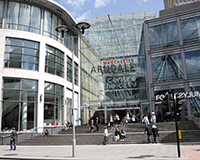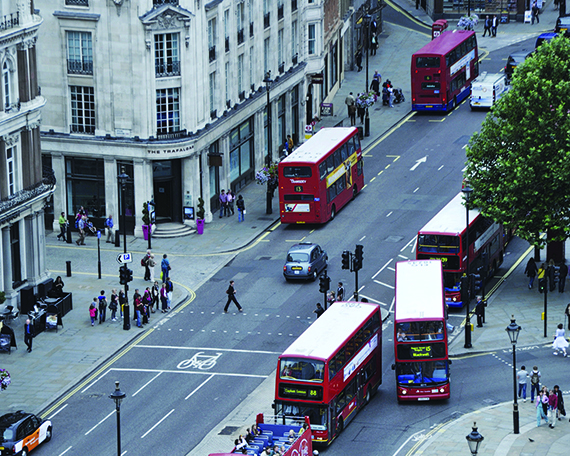The wheels on the bus go round and round – we all know that. But these days the passengers on the bus are wealthier, and there are more of them.
At least, that is what retailers and retail landlords are claiming as bus travel begins to figure strongly in their latest customer strategies.
Official statistics for the year to March 2014 show that there were 4.7bn bus journeys in England, half of them in London, up by 2.2% compared with the previous year. By the autumn the trend was slowing but was still encouraging.
In the big regional cities it is no longer true that buses are the preserve of blue-collar workers, students and pensioners. The suits are using them, too.
John Lewis, the middle class’s favourite department store, has not generally been associated with bus-borne customers. But managing director Andy Street hints that this is changing.
 The new 250,000 sq ft John Lewis store in Birmingham (pictured) is expected to rely heavily on public transport, especially buses.
The new 250,000 sq ft John Lewis store in Birmingham (pictured) is expected to rely heavily on public transport, especially buses.
Says Street: “We expect the Birmingham store to serve predominantly the north and west of the city – with Solihull taking the south and east – and we expect it to be served mostly by public transport, particularly buses.”
The changing bus demographic is fascinating some close observers of the retail scene.
David Fox is head of northern retail agency at Colliers International. He says the changing customer base of England’s buses is apparent in all the major cities.
“I suspect there are still retailers who think buses are about low-spending, low-value customers and value shoppers. But buses in the big cities move a fantastic number of people, car parking is expensive, and anecdotally we’re seeing a lot more people in the cities using public transport rather than driving into work, so there’s been a real resurgence of all sorts of people using the bus,” he says.
Fox suspects that the regional cities, particularly Manchester, are beginning to develop a bus demographic that looks more like London’s.
According to advertising specialists Transport Media, 64% of bus passengers in London are of the ABC1 social groups. It could be that Manchester’s 225m bus journeys a year are beginning, in a small way, to move towards a more upscale demographic.
Retailers are increasingly interested in bus services, too. The big surveying firms report that questions about bus connectivity are increasingly being asked, and the frequency of bus services is beginning to be an issue of importance to retail occupiers.
 Buses carried 40% of the Manchester Arndale Centre’s (pictured) 41.5m visitors in 2014 – the largest single means of transport to the mall. Trams carried about 10%, trains 15%, and the rest rode in private vehicles or walked.
Buses carried 40% of the Manchester Arndale Centre’s (pictured) 41.5m visitors in 2014 – the largest single means of transport to the mall. Trams carried about 10%, trains 15%, and the rest rode in private vehicles or walked.
Yet the bus-heavy demographic is not deterring big-name retailers with upscale reputations. US designer Michael Kors has signed a lease for a 7,000 sq ft store at the Arndale Centre, following in the footsteps of Drome and MooBoo, which have signed for 7,100 sq ft and 476 sq ft respectively.
The centre, owned by intu and M&G Real Estate, is proud of its bus services, says director David Allinson. He agrees with Fox that there appears to be a shift in the kind of customers using buses.
“We think about 65% of our shoppers are from the ABC1 socio-economic groups, higher than a few years ago, and many of them have to be coming by bus,” he says. “It could well be that Manchester‘s bus demographic is becoming more like London’s, thanks to the massive investment in new trams as much as anything else. Tram use is expected to grow from 30m to 44m a year by 2019, and that has spin-offs for buses, too.”
Such is the growth that the British Council for Shopping Centres is already thinking about changing patterns of transport. Research is underway, but is at a very early stage.
If the bus operators know what their customer demographic is, then they are not saying. Stagecoach, one of the largest bus operators, declined to comment while the Confederation of Passenger Transport, which unites all bus operators, said it was not aware of any data. Passenger Focus, the official government watchdog, was also in the dark.
The best guess is that if bus demographics really are changing – and changing to the benefit of retailers – then retailers’ own change of strategy may be the explanation.
Colliers’ Fox says: “One of the big drawbacks to shopping by bus used to be hauling your shopping home afterwards. But things have changed. Most retailers will now deliver anything faintly bulky, and that has possibly liberated people to use public transport in a way they wouldn’t have done before.”
The Arndale’s Allinson agrees, but adds: “We are seeing our customers drive strong growth in click-and-collect. They pick up small items and then take them home by public transport, rather than doing one big shop and carrying huge bags home.”
It was once said, probably by the aesthete and writer Brian Howard, that “anybody seen in a bus over the age of 30 has been a failure in life”. For decades that image has coloured many retail and retail property attitudes to bus travel. But, as surely as the wheels on the bus go round and round, so too may we have to revisit our prejudices.











